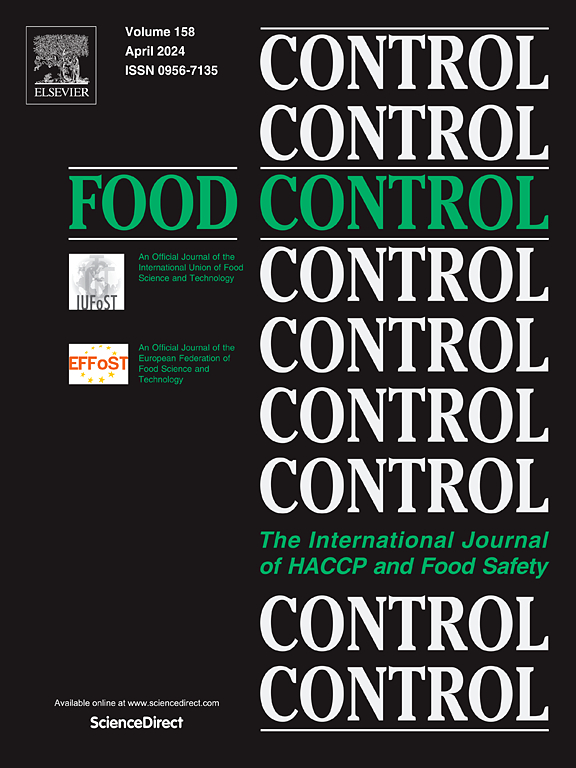A composite edible coating with green tea extract for controlling oil and chemical contaminants in deep frying meat
IF 5.6
1区 农林科学
Q1 FOOD SCIENCE & TECHNOLOGY
引用次数: 0
Abstract
Fried foods, valued for their taste and portability, are popular among consumers in our modern, fast-paced, high-pressure lifestyles but raise safety and nutritional concerns, especially with fried meats. These issues have driven increasing interest in the development of natural edible coating films for functional protection. This study developed an edible coating by integrating green tea extract (GTE) into a soy protein isolate (SPI) - carboxymethyl-cellulose (CMC). It can enhance fried meat safety by controlling frying process pollutants and extending shelf life through its antioxidant effects on fat and protein. The physical and functional properties of single (SPI or CMC), hybrid (SPI-CMC), and ternary composite (SPI-CMC-GTE, SCT) edible coating solutions were compared. SPI-CMC showed improved thermal stability due to enhanced hydrophobicity but suffered from poor dispersion due to increased particle size. The infrared, endogenous fluorescence spectrograms, and other physical parameter analysis indicated the presence of interactions between the phenolic active components of GTE and the protein-polysaccharides of SPI-CMC. Additionally, GTE incorporation altered the color of the edible coating solutions and improved the antioxidant activity. Applied to fried meat, coating with SCT demonstrated strong antioxidant activity, thermal stability, and homogeneity. These features help control oil absorption and reduce harmful substances, improving the quality and safety of deep-fried foods.

一种用于控制油炸肉类油脂和化学污染物的绿茶提取物复合食用涂层
在我们现代快节奏、高压的生活方式中,油炸食品因其口味和便携性而受到消费者的欢迎,但也引发了安全和营养方面的担忧,尤其是油炸肉类。这些问题促使人们对开发用于功能保护的天然可食用涂层越来越感兴趣。将绿茶提取物(GTE)与大豆分离蛋白(SPI) -羧甲基纤维素(CMC)相结合,制备了一种可食用涂层。它通过对脂肪和蛋白质的抗氧化作用,控制煎炸过程中的污染物,延长煎炸肉的保质期,从而提高煎炸肉的安全性。比较了单一(SPI或CMC)、杂化(SPI-CMC)和三元复合(SPI-CMC- gte、SCT)食用涂料溶液的物理性能和功能特性。由于疏水性增强,SPI-CMC的热稳定性得到改善,但由于粒径增大,分散性差。红外光谱、内源荧光光谱和其他物理参数分析表明,GTE的酚类活性成分与SPI-CMC的蛋白多糖之间存在相互作用。此外,GTE的加入改变了可食用涂层溶液的颜色,提高了抗氧化活性。应用于油炸肉类,SCT涂层表现出很强的抗氧化活性,热稳定性和均匀性。这些特点有助于控制油的吸收,减少有害物质,提高油炸食品的质量和安全性。
本文章由计算机程序翻译,如有差异,请以英文原文为准。
求助全文
约1分钟内获得全文
求助全文
来源期刊

Food Control
工程技术-食品科技
CiteScore
12.20
自引率
6.70%
发文量
758
审稿时长
33 days
期刊介绍:
Food Control is an international journal that provides essential information for those involved in food safety and process control.
Food Control covers the below areas that relate to food process control or to food safety of human foods:
• Microbial food safety and antimicrobial systems
• Mycotoxins
• Hazard analysis, HACCP and food safety objectives
• Risk assessment, including microbial and chemical hazards
• Quality assurance
• Good manufacturing practices
• Food process systems design and control
• Food Packaging technology and materials in contact with foods
• Rapid methods of analysis and detection, including sensor technology
• Codes of practice, legislation and international harmonization
• Consumer issues
• Education, training and research needs.
The scope of Food Control is comprehensive and includes original research papers, authoritative reviews, short communications, comment articles that report on new developments in food control, and position papers.
 求助内容:
求助内容: 应助结果提醒方式:
应助结果提醒方式:


